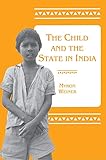The Child and the State in India : Child Labor and Education Policy in Comparative Perspective / Myron Weiner.
Material type: TextPublisher: Princeton, NJ : Princeton University Press, [2022]Copyright date: ©1991Description: 1 online resource (227 p.)Content type:
TextPublisher: Princeton, NJ : Princeton University Press, [2022]Copyright date: ©1991Description: 1 online resource (227 p.)Content type: - 9780691225180
- Child labor -- Government policy -- India
- Child labor -- Government policy
- Children -- India
- Education, Compulsory -- India
- Education, Compulsory
- HISTORY / Asia / India & South Asia
- Austria
- Basic Education
- Constitution of India
- English Poor Law (1601)
- Eswaran, Girija
- Factories Act (1948)
- Gandhi Labour Institute
- Gandhi, Mahatma
- Gujarat, educational system
- Gupta, Meena
- Hamilton, Alexander
- Harbans Singh Report
- Hartog Committee
- Illich, Ivan
- Indian Educational Services
- Indian Mines Act (1923)
- Indian National Congress
- Indian Social Institute
- Institute of Education (Pune)
- Karnataka
- Knights of Labor
- Knox, John
- Lakshmanan
- Luther, Martin
- Massachusetts
- Mines Act (1952)
- Old Deluder Satan Law (1647)
- Operation Blackboard
- Prema Seva Sadan
- Smith, Adam
- apprenticeship
- attitudes toward childhood
- bidi industry
- bonded labor
- brassware industry
- carpet industry
- common-school movement
- cottage industries
- dropout rates
- education, state policies
- expenditures on education
- female education and fertility rates
- fireworks industry
- goals of education
- indentured labor
- literacy rates
- match industry
- minimum wage
- nonformal education
- pottery industry
- school enrollments
- science teaching
- 331.3/4/0954 20
- HD6250.I42
- online - DeGruyter
| Item type | Current library | Call number | URL | Status | Notes | Barcode | |
|---|---|---|---|---|---|---|---|
 eBook
eBook
|
Biblioteca "Angelicum" Pont. Univ. S.Tommaso d'Aquino Nuvola online | online - DeGruyter (Browse shelf(Opens below)) | Online access | Not for loan (Accesso limitato) | Accesso per gli utenti autorizzati / Access for authorized users | (dgr)9780691225180 |
Frontmatter -- Contents -- Tables -- Preface -- 1 The Argument -- 2 India's Working Children -- 3 Dialogues on Child Labor -- 4 Dialogues on Education -- 5 Child Labor and Compulsory-Education Policies -- 6 Historical Comparisons: Advanced Industrial Countries -- 7 India and Other Developing Countries -- 8 Values and Interests in Public Policy -- Index
restricted access online access with authorization star
http://purl.org/coar/access_right/c_16ec
India has the largest number of non-schoolgoing working children in the world. Why has the government not removed them from the labor force and required that they attend school, as have the governments of all developed and many developing countries? To answer this question, this major comparative study first looks at why and when other states have intervened to protect children against parents and employers. By examining Europe of the nineteenth century, the United States, Japan, and a number of developing countries, Myron Weiner rejects the argument that children were removed from the labor force only when the incomes of the poor rose and employers needed a more skilled labor force. Turning to India, the author shows that its policies arise from fundamental beliefs, embedded in the culture, rather than from economic conditions. Identifying the specific values that elsewhere led educators, social activists, religious leaders, trade unionists, military officers, and government bureaucrats to make education compulsory and to end child labor, he explains why similar groups in India do not play the same role.
Mode of access: Internet via World Wide Web.
In English.
Description based on online resource; title from PDF title page (publisher's Web site, viewed 29. Jun 2022)


